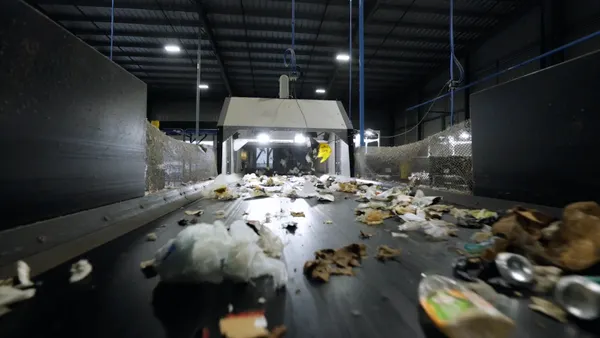Dive Brief:
- California has experienced an estimated 30% drop in the volume of beverage containers reclaimed through its deposit program from March 14 to May 22, compared with last year, according to preliminary data from the California Department of Resources Recycling and Recovery (CalRecycle). Accurate final data will take at least 90 days to compile, CalRecycle Public Information Officer Lance Klug told Waste Dive.
- The drop in redeemed beverage container volume is believed to be caused by a combination of temporary redemption centers closures and consumers voluntarily avoiding venturing into public spaces. The shift equates to about a $61 million reduction in the amount of deposit money redeemed.
- On April 22, Gov. Gavin Newsom signed an executive order suspending for 60 days several regulations including the requirement for beverage redemption centers to operate as well as the statewide single-use plastic bag ban. Most states with bottle bills have suspended their programs or regulation enforcement for a limited time during the pandemic.
Dive Insight:
CalRecycle does not have data on what is happening to the containers that usually would be redeemed. Consumers might be putting them in curbside recycling bins, throwing them in the trash or stockpiling them for future redemption. Recycling industry analysts have cited nationwide anecdotal evidence — but no firm data — indicating some people are stockpiling used beverage cans while others are throwing them out.
California and Michigan are the two largest contributors of deposit program UBCs that go into making new aluminum cans. Reduced UBC volumes during the pandemic are affecting manufacturers' feedstock supply, and some analysts suggest that might lead to greater amounts of virgin material being used for can manufacturing. CalRecycle is aware of this supply chain disruption, as well as similar trouble for glass and fiberglass manufacturers.
Currently, the department is starting to see the lower volume trend begin to reverse as stay-at-home orders are loosened and lifted. "We anticipate a corresponding increase in volumes once the state reopens," Klug said.
California's redemption program has sustained ongoing criticism over its effectiveness and was strained further by the sudden closure of 284 redemption centers by the large company rePlanet last summer. Some recycling advocates say the redemption program is so broken it drove rePlanet and hundreds of other recycling centers out of business. They've been calling on both CalRecycle and state legislators to take action to prevent the entire system from collapsing.
The number of available recycling centers declined by an estimated 53% between 2013 and 2019, according to one recent report from the Changing Markets Foundation and National Stewardship Action Council (NSAC). The report says this has contributed to a declining state redemption rate landing at 66% for 2018 – a figure which does not include 12% of containers collected through curbside and drop-off programs – and argues this is lower than some other states with bottle bills. CalRecycle reports its overall container recycling rate, a statutorily defined term that is calculated differently, was 76% in 2018 and 75% in 2019.
In March, CalRecycle issued a report to the legislature that outlined ways to make the redemption program more economical by reducing or eliminating public costs of supporting less profitable recycling centers, while maintaining the public's ability to redeem containers. The report offered options for expanding or reconfiguring access in "convenience zones," adding new redemption methods and boosting recycled material markets.
In January, the state made $5 million in funding available for pilot programs to boost redemption opportunities and improve recycling rates in unserved areas. Applications are ongoing through January 2022, but some believe the state isn't moving fast enough with getting the projects off the ground.
"We're disappointed to see that these pilot programs haven't yet been approved by CalRecycle. We're advocating for rapid adoption of pilot programs to bring redemption opportunities to areas where people have no convenient access and can't get their money back," said Susan Collins, president of the Container Recycling Institute (CRI).
CRI also hopes the state continues to appropriately use the $400 million in the beverage container fund and sub-accounts to support the redemption process in California, a point also raised in the NSAC report.
"During the 2008/2009 recession, the state borrowed from the beverage container program and used the money for the general fund, which forced the entire program into 'proportional reduction,' cutting payments to redemption centers," Collins said.
The money in the fund spent by the program is directed by statute, according to CalRecycle. It is used to pay refunds for the containers returned for recycling, provide supplemental payments to recycling centers and others in the industry, offset beverage manufacturer processing fees and pay for program administration.
Clarification: This article has been updated to reflect the full extent of California's container recycling rates in 2018 and 2019.









